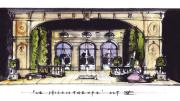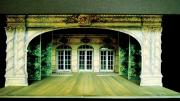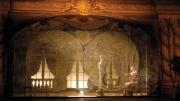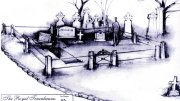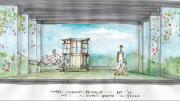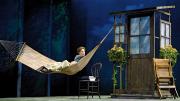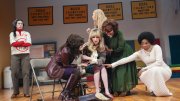Carl Sprague ’84 did plenty of theater at Harvard, though he didn’t act much (“I’m a terrible actor—very wooden,” he says). Instead, he directed shows in the Houses, at the Loeb Ex, and even a production of Euripides’ The Bacchae in Harvard Stadium. “I had a hard time finding designers for the shows,” he recalls, “and a couple of people bailed out on me, which meant I had to build it myself. It turned out that was the part of directing I enjoyed the most.” Twenty-five years later, he has become a highly respected designer and art director for both theater and feature films (see www.carlsprague.com); his credits include Martin Scorsese’s The Age of Innocence (1993), Steven Spielberg’s Amistad (1997), David Mamet’s State and Main (2001), and Wes Anderson’s The Royal Tenenbaums (2001). He also worked on several films scheduled for 2010 release, among them The Company Men (with Tommy Lee Jones ’69), and Salt (with Angelina Jolie).
The design process for theatrical sets and motion-picture settings parallels the sketching a fashion designer does for a couture dress that later, with the aid of a seamstress, takes form in fabric, plastic, metal, or other materials. For theater, after reading the play and hashing out ideas with the director, Sprague sketches some set designs; he’ll take those that pass muster and turn them into drawings that can be built. The work has elements of architecture and presents practical problems to solve. A door-slamming Feydeau farce, 13 Rue de L’Amour, at Shakespeare & Compa-ny in Lenox, Massachusetts, required scene changes in “five seconds, and there was no wing space or fly space, only room for a wall of flats,” Sprague explains. He made the whole set a “series of hinged flipper panels that could, in a few seconds, transform from a doctor’s office into a dress shop.”
Sprague enjoys both generating and executing visual ideas (“There are things you figure out with your pencil instead of your head”), though if he had to choose, he would come up with ideas and delegate the drafting. “I’m only an artist by necessity,” he says. “I never fancied myself a painter or someone who did drawings. I’ve worked with brilliant draftsmen who don’t even aspire to say anything with their work, and with people who had no graphic ability, but brilliant ideas.” Sprague notes that some film directors are skilled visual artists themselves; Wes Anderson, for example, brought his own Tenenbaums drawings to the art department, which set out to detail and build his visions.
For a theatrical show at the Berkshire Theatre Festival (near his home in Stockbridge, Massachusetts), Sprague might make five or six pages of construction drawings, but a movie can require 10 to 50 times that many. In Hollywood, there are more job titles—art director, set designer, model builder—each with specialized skills and its own labor unions. On a feature film, the top position—“the title to aspire to,” says Sprague—is “production designer,” a designation first granted to William Cameron Menzies on Gone with the Wind (1939), for which he sketched all aspects of the movie, including costumes, and conceived the overall “look” of the production. Sprague has been production designer for a half-dozen films.
Movies can sometimes “spend $100 million without having thought through an approach, or really even having a concept for the project,” he says. Yet, some Hollywood designers can build great sets “just by waving their hands around and talking on a cell phone,” he notes. “People achieve amazing results doing just that.
“In theater, you have to have some idea to work at all,” Sprague continues. “I wouldn’t spend $500 in theater without some kind of metaphor, or vision, or idea of what it means.” For A Christmas Carol at the Berkshire Theatre Festival, mounted on a “vest-pocket stage,” Sprague made the whole set revolve around Scrooge’s bed (with the four-poster’s curtains forming another stage within the stage), at once solving a practical problem and making a conceptual statement about the piece.
In general, he says, design work on the East Coast is more theatrically based; in the Berkshires, his own work at the Berkshire Theatre Festival has ranged from The Misanthrope to American Buffalo, Night of the Iguana, and Glass Menagerie. “The opportunities for doing theater locally can be pretty exciting,” he says.
The Berkshires also provide the setting for his next big project, a film adaptation of the short novel Summer that Edith Wharton, who lived for years at The Mount in Lenox, wrote in Paris during World War I. Sprague has drafted a screenplay and plans to direct; he is raising money with a “beautifully impatient” producing partner. “The novel is a big, juicy mash note to the Berkshires,” Sprague says. “There’s a lush, beautiful romantic vision of a steamy small town in prewar rural New England. Externally, it’s a very bitter story about a love triangle that ends up not working out for anyone, but it’s also a very sexy, sweet summer romance. It’s an enormous pleasure to conjure up that world.”
